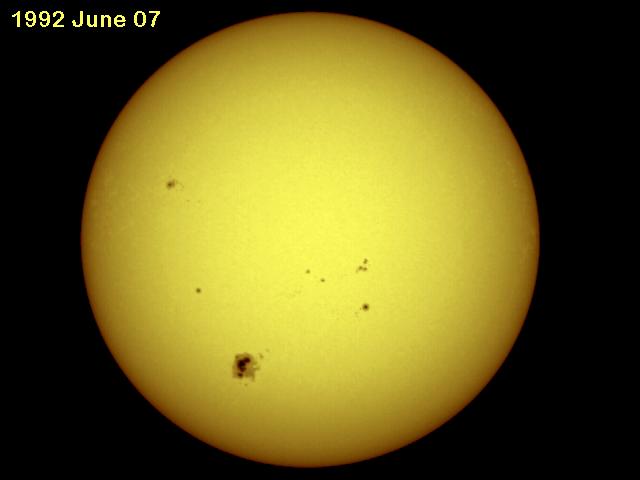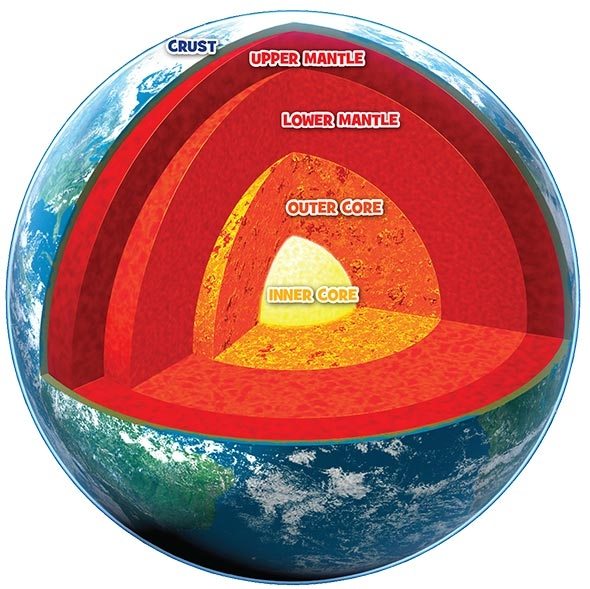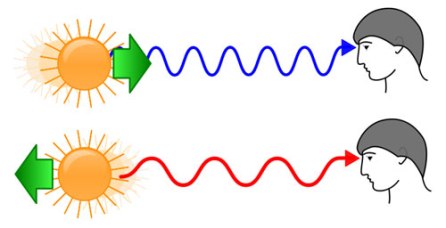
Recognize this?
You might, if you’ve ever seen the sun through a telescope before. What you’re seeing is the photosphere, the layer of the sun whose light reaches Earth. This is the only layer you’ll ever see, without the aid of a solar eclipse.
Wait a second…what do I mean, layers? I mean, I know what a layer is, but what kind of layers does the sun have?
Well, it’s got a few, just like the Earth.
You may remember from maybe sixth grade that the Earth is made up of a couple of distinct layers.

Don’t worry, we will definitely be exploring the Earth more closely later on. My astronomy textbook covers it a little, but I’ve got a whole Earth science textbook to draw from for these posts.
For now, though, I just want to compare the Earth’s layers to those of the sun.
It is surprisingly difficult to find a simple but elegant diagram of the sun’s layers. Anyway…here you are.

Over the next few parts, we’ll get up close and personal with each one of these parts of the sun. For now, we’re going to focus on the photosphere, that thin surface layer right above the convective zone.
As I’ll describe later, the convective zone is a region of rising and sinking gases. This has an interesting effect on the photosphere…

You don’t normally see these granules in photos of the sun, but they’re there. This is what the surface of the sun really looks like, if you could get a really good, detailed image. It’s not smooth at all—it’s patterned with these little dark-edged regions.
How big do you think these are?
This image doesn’t provide much in the way of perspective, I know. But venture a wild guess. A few inches across? A few feet? Maybe a few miles?
Try the size of Texas, USA.
Yup. Each one of these granules is that big.
They’re not permanent, either. The gases below the photosphere are slowly rising and sinking, causing little Texas-sized currents of rising and sinking gas to break up the photosphere. This is called convection.
So what is convection, anyway?
It happens all the time—it’s a basic law of nature. Have you ever heard the phrase “heat rises”?

When I was little, I was convinced that it was better to sleep in the top bunk of my bunk bed in the winter—supposedly because “heat rises,” and I’d be warmer up there. The truth is, it’s not really warm enough up there to feel the difference.
See, that little saying isn’t really true for the height of a bunk bed off the floor. But when we’re dealing with the hot gases of the sun—hot enough to provide energy for photosynthesis to an entire planet—it’s a different story.
Hot gases rise because as they heat up, their particles spread out, making them less dense. But as they rise, they get farther from the core of the sun and cool down a little. This makes them sink…and heat up all over again.
Now imagine that going on in little convection currents—well, little if you count Texas as little—all over the surface of the sun.
Convection also occurs in much larger supergranules. These are regions of around 300 granules each—about twice the size of Earth’s diameter. Just like the smaller granules, these supergranules are slowly rising at the center and sinking around the edges.
I’ll bet you’re wondering how the heck we even know this. How can you tell from an image that the sun’s surface is mottled because of convection?
Well…you can’t. But…remember the Doppler effect from my last post?
In case you’re not familiar with it, I’ll cover it briefly here. The Doppler effect refers to the apparent change in wavelength as an object moves towards you or away from you.

Basically, if an object such as a star is moving toward you, the spectral lines its atoms produce shift a little toward the blue end of the spectrum, or a little toward the red end…like so.

This is how we can see little shifts in motion on the sun’s surface. They may not be easy to image from one moment to the next, but we can measure the Doppler shift of the sun’s granules.
What we see is a little blueshift in the center where the gas is rising, and a little redshift around the edges where the gas is sinking.
One reason I decided to introduce you to the photosphere before any of the other layers is because it is the only layer we can observe directly.
Even astronomers can’t see beyond the photosphere—they depend on light reaching their instruments, and the gases below the photosphere are so dense that the light they emit can’t actually escape them.
That means that everything we know about the deeper layers of the sun, we know from observing the photosphere. And you’d be surprised what all the photosphere can tell us.
For example…there’s something called limb darkening.

It’s extra pronounced in this image. Do you notice that the light from the sun seems to get a bit dimmer closer to the edge?
Well…it doesn’t just seem to get dimmer. It actually does. In this image, the effect makes the curvature of the sun’s surface more obvious, because that’s what our eyes are trained to see when we think we see shading.
But that’s not why the sun’s edges appear darker.
Think about it. Shading on a drawing adds depth, but only because the subject of the drawing is being illuminated by some other light source. The sun is its own light source. There’s no reason to shade its edges.
That’s why the sun normally appears more like a flat disk. The effect of limb darkening has just been enhanced in this image to make it a bit more obvious.
What’s actually happening may surprise you…and it proves that energy is flowing outward from the center of the sun toward the photosphere.
When you look at the surface of the sun head-on, you’re looking directly through the photosphere’s outer layers at hotter, brighter regions beneath. That means you can easily see those brighter regions.
But if you look at the edge of the sun…your line of sight is essentially just grazing the surface of the photosphere. That region is dimmer, so the edge of the sun actually appears dimmer.
Now you’re probably wondering why this effect isn’t called edge darkening. Well…that’s just a nuance of language. Astronomers call the edge of any cosmic object the limb. I have no idea why, but that’s how it works.
Anyway, that’s it for the photosphere. Next up, let’s take a small step back…into the chromosphere.